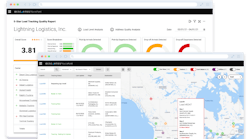It has become human nature – when we hear a notification from our phones, we automatically reach for it. When you’re behind the wheel, that instinctive need to check our devices can be deadly. For drivers who are operating a large truck, it’s especially important to ensure that all distractions are kept to a minimum. Anything that could take a driver’s eyes from the road and their attention from their vehicle can be the reason for an accident or injury – or worse.
There are a number of tools and resources that companies can leverage to keep their fleets safe. Helping your drivers understand the root causes of distracted driving, encouraging best practices, and using technology to implement training and reinforce corrective actions can significantly decrease the likelihood of accidents occurring on our nation's roads.
Understanding distractions are everywhere
Technology can make distracted driving a major issue for drivers – especially professional drivers who spend most of their time on the road. From talking on the phone or fiddling with the stereo, to eating and drinking while driving – many activities that seem innocuous can lead to a collision. According to the National Highway Traffic Safety Administration (NHTSA) and U.S. Department of Transportation (DoT), more than 3,000 deaths were caused by distracted driving in 2016 alone. Texting stands out as one of the riskiest behaviors. Sending or reading a text can take a driver’s eyes off the road for an average of five seconds – enough time to drive the length of an entire football field without paying attention.
There are federal laws that prohibit drivers – whether it’s a parent driving an SUV or a truck driver with a cross-country haul – from texting. Most fleets have company rules that call for the termination of an operator caught violating these laws. As law enforcement officials continue to battle against driving distractions, operators need to be alert to the dangers and penalties for distracted driving. Employers should educate their drivers on the legal consequences of distracted driving and encourage them to commit to eliminating risky behaviors through company-wide training.
Encouraging good driving behavior behind the wheel
To tackle risky driving behaviors, fleet managers can point to simple tips that will help drivers better defend themselves against preventable accidents. A few best practices to keep in mind are:
- Turn off unnecessary devices and put them out of reach before starting to drive.
- Set the destination on the GPS before a journey and mount the device so it remains hands-off.
- Practice defensive driving and think about everyone else around you.
- Fend off daydreaming by playing “find the distracted driver” – look for drivers failing to use turn signals or maintain their lane and stay aware of them at all times.
- Take scheduled breaks to keep from getting too tired to drive safely.
The DoT and the National Tank Truck Carriers (NTTC) are great resources to reference for up-to-date best practices against distracted driving. In particular, the NTTC created a Zero Distractions campaign wherein they petition to make distracted driving illegal in all U.S. states and drivers can pledge to stay focused on the road.
The crucial role of technology in fleet safety’s future
With the growth of in-cab data and technology, professional truckers are susceptible to distraction than. For operators, tablets and other mobile devices have entered the cab in the form of navigation systems, fleet management and workflow devices, and fleet dispatching, routing and tracking systems. It’s vital for this technology to be as non-distracting as possible so consider using devices that allow for greater oversight, to not only communicate with drivers, but ensure only relevant apps such as those designed for navigation and driver coaching are accessed while driving.
Advancements in vehicle safety technology can also help keep commercial truck drivers more focused on the road. Driver-assist systems such as reverse sensors and cameras, adaptive cruise control and hands-free Bluetooth connectivity for communications are steadily making their way into cabs across the country. In-vehicle technology is also being used to identify risky driving behavior and provide instruction to drivers in real-time to help prevent accidents. Zonar Coach, for example, helps monitor drivers’ behaviors and provide real-time feedback when they are speeding, swerving or breaking too hard – telltale signs of distracted driving. These types of systems can also capture video of driving events so drivers can learn from past mistakes and managers can reward safe driving behaviors.
In today’s hyper-connected world, anyone can become a distracted driver. This is particularly dangerous for those operating commercial trucks and vehicles – taking your eyes away from the road for even seconds can have life-changing consequences. Understanding what causes distracted driving, recognizing how to prevent this behavior, and leveraging the latest technology and techniques from organizations and companies dedicated to keeping us all safe on the road is critical to ensure truck drivers and operators stay safe and focused while behind the wheel.



